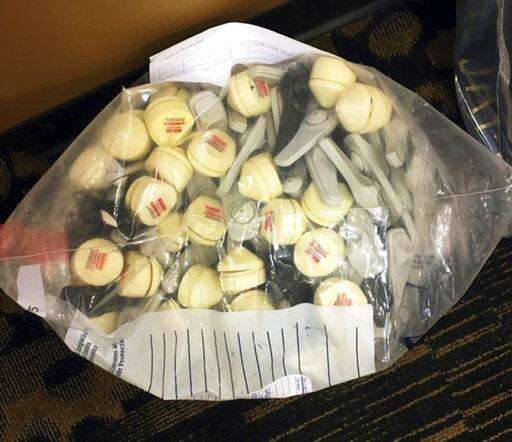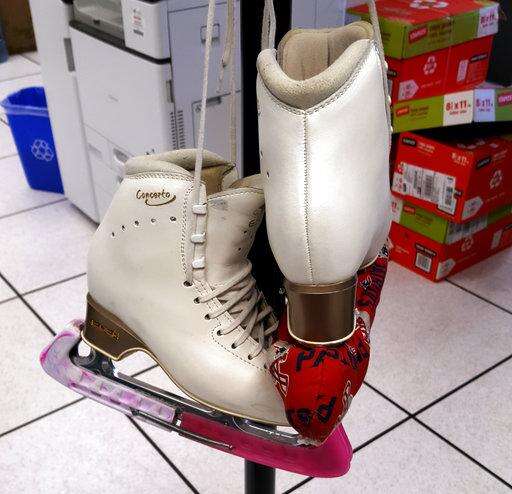FILE - In this Feb. 21, 2013 file photo, an inmate at the Madera County Jail is taken to a housing unit at the facility in Madera, Calif. Independent researchers say that California voters' decision to reduce penalties for drug and property crimes in 2014 led to a jump in thefts, particularly car burglaries and shoplifting. The Public Policy Institute of California reported Tuesday, June 12, 2018 that larcenies increased about 9 percent from 2014 to 2016. Thefts from motor vehicles accounted for about three-quarters of the increase. San Francisco alone recorded more than 30,000 auto burglaries in 2017. (AP Photo/Rich Pedroncelli, File)
The Associated Press
SACRAMENTO, Calif. (AP) - California voters' decision to reduce penalties for drug and property crimes in 2014 contributed to a jump in car burglaries, shoplifting and other theft, researchers reported.
Larcenies increased about 9 percent by 2016, or about 135 more thefts per 100,000 residents than if tougher penalties had remained, according to results of a study by the nonpartisan Public Policy Institute of California released Tuesday.
Thefts from motor vehicles accounted for about three-quarters of the increase. San Francisco alone recorded more than 30,000 auto burglaries last year, which authorities largely blamed on gangs. Shoplifting may be leveling off, researchers found, but there is no sign of a decline in thefts from vehicles.
Proposition 47 lowered criminal sentences for drug possession, theft, shoplifting, identity theft, receiving stolen property, writing bad checks and check forgery from felonies that can bring prison terms to misdemeanors that often bring minimal jail sentences.
While researchers can link the measure to more theft, they found it did not lead to the state's increase in violent crime.
Violent crime spiked by about 13 percent after Proposition 47 passed, but researchers said the trend started earlier and was mainly because of unrelated changes in crime reporting by the FBI and the Los Angeles Police Department.
The FBI broadened its definition of sexual crimes in 2014, while the LAPD improved its crime reporting after previously underreporting violent crimes. If it weren't for those changes, researchers found California's violent crime rate would have increased 4.7 percent from 2014 to 2016.
Researchers compared California's crime trends to those in other states with historically similar trends. They found the increase in California's violent crime rate was less than that of comparison states, but larcenies jumped in California as they declined elsewhere.
California still has historically low crime rates despite recent changes in the criminal justice system aimed at reducing mass incarceration and increasing rehabilitation and treatment programs, said Lenore Anderson, executive director of Californians for Safety and Justice, who led the drive to pass Proposition 47.
"This report shows we are making progress," she said in a statement calling for less spending on prisons and more on programs to help reduce the cycle of crime.
The ballot measure led to the lowest arrest rate in state history in 2015 as experts said police frequently ignored crimes that brought minimal punishment.
Jail bookings in 12 sample counties dropped about 8 percent, driven by a reduction in bookings for Proposition 47 crimes, while cite and releases increased, researchers found.
Offenders convicted of those crimes were about 3 percent less likely to be convicted of a new crime within two years, but the researchers said it's not clear if that was because they didn't commit new crimes or because they were less likely to be arrested and prosecuted because of the lower penalties.
Reduced penalties mean fewer drug addicts now seem to be getting treatment, then "are stealing to support their habit," said San Luis Obispo County Chief Probation Officer Jim Salio, president of Chief Probation Officers of California.
Morgan Hill Police Chief David Swing, president of the California Police Chiefs Association, said researchers' findings "are consistent with what police chiefs across the state have seen since 2014" and show the need for a proposed initiative intended for the November ballot that would partly roll back the 2014 law.
It would allow prison sentences for serial thieves, reinstate DNA collections from those convicted of the crimes where penalties were reduced, and bar the earlier release of criminals convicted of additional violent, serious and sexual crimes.
FILE - In this Oct. 3, 2012 file photo, inmates pass the time at the Los Angeles County Men's Central Jail, operated by the Los Angeles County Sheriff, in downtown Los Angeles. Independent researchers say that California voters' decision to reduce penalties for drug and property crimes in 2014 led to a jump in thefts, particularly car burglaries and shoplifting. The Public Policy Institute of California reported Tuesday, June 12, 2018 that larcenies increased about 9 percent from 2014 to 2016. Thefts from motor vehicles accounted for about three-quarters of the increase. San Francisco alone recorded more than 30,000 auto burglaries in 2017. (AP Photo/Reed Saxon, File)
The Associated Press

FILE - This Sept. 6, 2017 file photo provided by U.S. Immigration and Customs Enforcement's Homeland Security Investigations shows security sensors removed from stolen clothing, along with more than $20 million in goods stolen by a San Diego-based shoplifting ring. Independent researchers say that California voters' decision to reduce penalties for drug and property crimes in 2014 led to a jump in thefts, particularly car burglaries and shoplifting. The Public Policy Institute of California reported Tuesday, June 12, 2018 that larcenies increased about 9 percent from 2014 to 2016. Thefts from motor vehicles accounted for about three-quarters of the increase. (ICE Homeland Security Investigations via AP, File)
The Associated Press

FILE - In this May 12, 2016 file photo, Jeremiah Munavu, lead technician at Auto Glass Now, installs a new side window on a car in a garage in San Francisco. Independent researchers say that California voters' decision to reduce penalties for drug and property crimes in 2014 led to a jump in thefts, particularly car burglaries and shoplifting. The Public Policy Institute of California reported Tuesday, June 12, 2018 that larcenies increased about 9 percent from 2014 to 2016. Thefts from motor vehicles accounted for about three-quarters of the increase. San Francisco alone recorded more than 30,000 auto burglaries in 2017. (AP Photo/Jeff Chiu, File)
The Associated Press

FILE - In this May 12, 2016 file photo, Julio Lara, manager at Auto Glass Now, holds up a spark plug attached to a Sharpie pen used to break a car window while being interviewed in San Francisco. Independent researchers say that California voters' decision to reduce penalties for drug and property crimes in 2014 led to a jump in thefts, particularly car burglaries and shoplifting. The Public Policy Institute of California reported Tuesday, June 12, 2018 that larcenies increased about 9 percent from 2014 to 2016. Thefts from motor vehicles accounted for about three-quarters of the increase. San Francisco alone recorded more than 30,000 auto burglaries in 2017. (AP Photo/Jeff Chiu)
The Associated Press

FILE - This undated photo provided by the San Francisco Police Department shows a pair of ice skates belonging to U.S. Olympic figure skater Marissa Castelli, stolen in a car break-in while Castelli and her parents visited San Francisco. Independent researchers say that California voters' decision to reduce penalties for drug and property crimes in 2014 led to a jump in thefts, particularly car burglaries and shoplifting. The Public Policy Institute of California reported Tuesday, June 12, 2018 that larcenies increased about 9 percent from 2014 to 2016. Thefts from motor vehicles accounted for about three-quarters of the increase. San Francisco alone recorded more than 30,000 auto burglaries in 2017. (San Francisco Police Department via AP, File)
The Associated Press